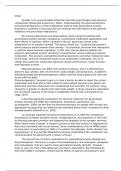Initial
post
Anxiety is an uncomfortable state that has both psychological and physical
components (Rosenthal & Burchum, 2021). Understanding the pharmacokinetics
and pharmacodynamics of the medications used to treat generalized anxiety
disorders is essential in ensuring that we minimize the side effects of the patients
related to the prescribed medications.
My clinical experiences and observations when caring for patients with
generalized anxiety disorder changed as I understood medication applications and
their effects on patients. When I worked in the jail, physicians would order
metoprolol for an inmate's anxiety. The doctor would say, "Lowering the patient's
blood pressure would improve their anxiety." As providers, we know that metoprolol
is used for blood pressure regulation. In this case, the jail doctors address the
patient's generalized anxiety resulting in hypertension versus ordering anxiolytic
medication. This scenario exemplifies pharmacodynamics and what metoprolol does
to the body, and how metoprolol works as an antianxiety medication. Shu et al.
(2019) discussed how metoprolol improves cardiac performance, motor function,
and regulates anxiety.
Pharmacokinetics can differ from person to person, and it is affected by a
person's age, gender, diet, environment, body weight, and pregnancy. A patient's
pathophysiology and pharmacogenetics affect how the drug impacts the cells and
works with the body.
Pharmacogenetics' long-term goal is to help a doctor be able to select the correct
medication and dose that is best suited for each patient because your genes can
determine how the medications are metabolized and secreted. For instance, drug
clearance is greater in obesity than lean body weight. A drugs clearance represents
the functional capacity of the body to metabolize and excrete a drug (Barras &
Legg, 2017)
A few FDA-approved medications for first-line treatment for generalized
anxiety disorder are SSRIs like venlafaxine, duloxetine, paroxetine, and
escitalopram. SSRIs are the first-line pharmacotherapy for people with anxiety and
depression because they are effective and tolerated better when compared to other
antidepressants (Edinoff et al., 2021).
An example would be the pharmacodynamics of an SSRI like venlafaxine.
Venlafaxine increases serotonin levels, norepinephrine, and dopamine in the brain
by blocking transport proteins and stopping the reuptake at the synaptic terminal.
When these levels increase, it causes a person to feel less anxious or depressed or
feel more controlled with social anxiety. Some considerations that an APRN needs
to know prior to prescribing an SSRI is if a patient has allergies, drinks alcohol, has
hypertension, or any suicidal idealization because medications like venlafaxine are
contraindicated for patients with a history of these.
The second line of choice medications for generalized anxiety disorder are
benzodiazepines. There are a couple of benzodiazepines, like lorazepam, diazepam,
and clonazepam, that are used to treat generalized anxiety disorder. However,
there is only one that is FDA-approved, and that is alprazolam. Benzodiazepines
bind with GABA-A receptors, enhancing the effects of gamma-aminobutyric acid
, Initial
(GABA), which mediates the calming or inhibitory effects of alprazolam in a person's
post
nervous system (George & Tripp, 2023).
Resources




